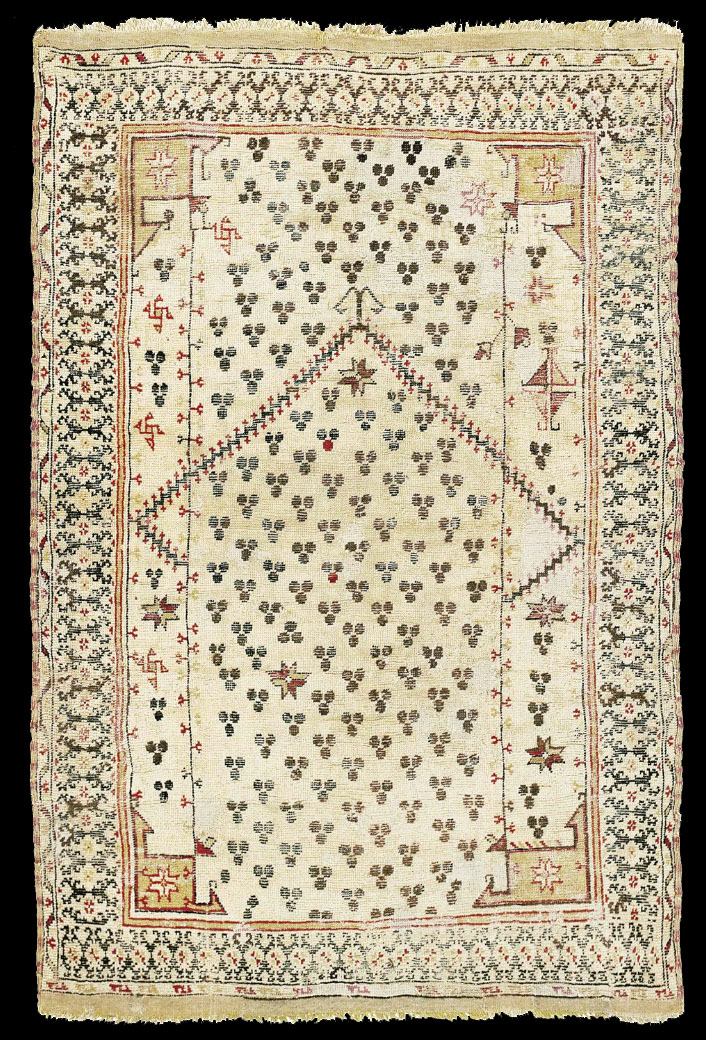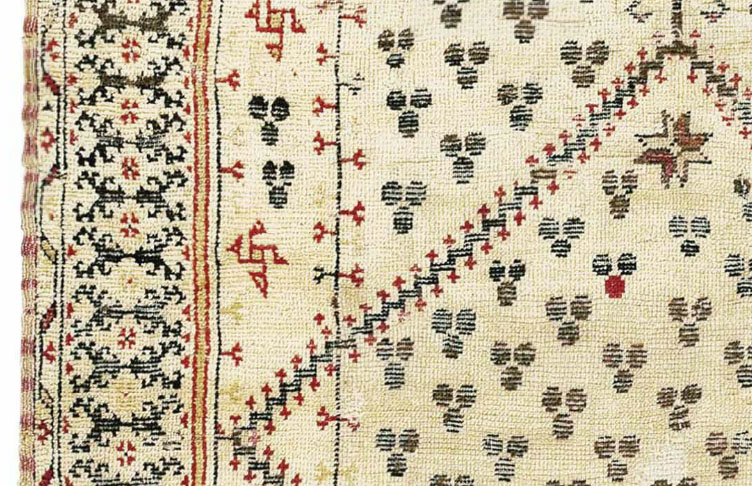|
Price Realized £229,250 ($369,780)
Sale Information
Christies SALE 5106 —
ORIENTAL RUGS AND CARPETS
24 April 2012
London, King Street
Lot Description
A SELENDI PRAYER RUG
WEST ANATOLIA, LATE 16TH OR EARLY 17TH CENTURY
Uneven overall wear, corroded black with associated repiling, scattered
reweaves and small repairs, selvages original, end kilims mostly original
and secured, backed
5ft.10in. x 3ft.11in. (178cm. x 119cm.)
Provenance
C.H. Boehringer & Sohn, Ingelheim-am-Rhein, gifted on 6 June 1958 to
J.R.Geigy Ltd
Pre-Lot Text
THE BOEHRINGER CINTAMANI PRAYER RUG
Literature
Jürg Rageth, 'A Selendi Rug: An Addition to the Canon of White-Ground
Cintamani Prayer Rugs', Hali 98, May 1998, pp.84-91 and front cover.
Stefano Ionescu, Handbook of Fakes by Tuduc, Boston, 2010, p.130.
Lot Notes
In his study of white ground classical Anatolian rugs and carpets Marino
Dall'Oglio notes that there is a total of about thirty or so white ground
cintamani rugs and carpets of which about twenty five are relatively small,
similar in size to the present rug (Marino Dall'Oglio, 'White Ground
Anatolian Carpets', in Robert Pinner and Walter Denny (ed.), Oriental Carpet
and Textile Studies II, Carpets of the Mediterranean Countries, London,
1986, p.191). Of these over half are prayer rugs which share many features
with the present rug. In his publication of the present rug Jürg Rageth
located thirteen complete and partial examples of which the present rug is
one of the very best preserved (Rageth, op.cit, pp.84-91). The group is
characterized by a restricted palette with overall cintamani field designs
and niches with stepped profiles. In contrast to the 'bird' Ushak and
related rugs with which the present rug shares the palette and basic
structure, none of these rugs appear ever to have been intended for the
Western European export market. None have survived in Western Europe, and
none are depicted in paintings. Also interesting is the fact that virtually
none have surfaced in Turkey; all have an Eastern European provenance and
have generally survived in Transylvanian churches. Ionescu notes that there
is one fragment noted to have come from Turkey (Stefano Ionescu, Antique
Ottoman Rugs in Transylvania, Rome 2005, p.54), and quotes an article by
Alberto Boralevi ('Back To Transylvania', Ghereh 33). He does not however
give a page reference and the quote proves elusive. The popularity of all
white ground Ottoman rugs in a Transylvanian context is demonstrated both by
the fact that Hungarian and Transylvanian inventories from the late
sixteenth century onwards refer specially to "white rugs", and by the
proportion that survive today in Protestant churches there (Boralevi, op.cit,
p.17).
This prayer rug was most probably woven in Selendi, near Ushak in West
Anatolia, where there appears to have been a workshop from which many of the
white ground cintamani prayer rugs originate. This theory is supported by
Halil Inalcik's research into Ottoman price registers (Halil Inalcik, 'The
Yuruks', in Pinner and Denny op.cit, pp.39-65 esp.p.58). In an Ottoman
listing of rugs, their designs, origins and maximum prices dating from 1640,
one entry under the section Seccade (Prayer Rugs) reads: Selendi style with
leopard design. For further discussion on the use of cintamani in the
decorative arts please see Gerard Paquin, 'Cintamani', Hali, no.64,
pp.104-119.
This rug is unusual for its tripartite division of the field, a feature only
seen elsewhere in one largely rewoven rug in the National Museum of Art in
Bucharest (Ionescu 2005 op.cit., no.49, p.105; Rageth, op.cit., no.14,
p.91). The drawing of the prayer arch on the Bucharest rug however is
completely within the restored section, indicating that the present rug must
have served as the model for the restorer, very possibly Theodor Tuduc when
he wove the repair. The majority of the thirteen cintamani prayer rugs also
share the same border as is found here, with minor variations. It is a
border that is only found on one other rug, a Lotto variant rug formerly in
the Wilhelm von Bode Collection (Rageth, op.cit, pl.8, p.88).
Despite extensive enquiries which he details in his article Jürg Rageth
could not track down the provenance of this rug prior to its ownership by
Boehringer in 1958. Ionescu notes that it was previously in a Protestant
Lutheran parish and then in the possession of Theodor Tuduc, but does not
quote the source (Ionescu, 2010 op.cit., p.130). Boehringer was a renowned
collector of art, and a great Oriental rug enthusiast, and it seems likely
that the prayer rug was a personal gift to a particular partner at Geigy.
Photographs of Boehringer's collection are still held in the archive of the
Museum of Islamic art in Berlin, although sadly the cintamani prayer rug
does not appear. The rug was rediscovered in 1995 after a long period when
it was not appreciated; it was cleaned and re-backed at that time. It is one
of only two rugs of this group that are in private hands.
This rug was sampled on 15 March 1995 by Dr Georges Bonani of ETH-Zurich,
sample no.ETH-14055. The C14 results indicated a calibrated age of 1455-1647
with 100 probability.
|


